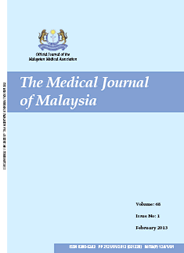MJM, Vol 70 Supplement 1 September 2015
Ending AIDS in Malaysia - Myth or Reality?
Ministry of Health Malaysia
ABSTRACT
Since the first case of HIV detected in 1986, and through vigorous activities in detecting new cases, Malaysia reached its peak of HIV epidemic in 2002 with HIV infection at 22/100,000 population. Between 2003 and 2009, the country observed a significant decline of cases resulting from countrywide implementation of Harm Reduction (HR), Prevention of Sexually Transmitted HIV and Prevention of Mother to Child Transmission (PMTCT). Since end of 2005, HR has been the mainstay of the country’s responses that resulted in further decline of new HIV infection in the country. But this decline has since stalled from 2010 onwards.
Several activities and approaches were taken in fighting HIV and AIDS, through the first National Plan of Action on AIDS in 1988, followed by another plan of action in 1998. The National Strategic Plan for HIV and AIDS (NSP) was established for 2006-10, and continued for 2011-2015, in which the country has observed increasing programme coverage for injecting drug users, continuation of impactful programme and scaling up prevention activities among key affected and vulnerable populations. These gave an impact for the country in reaching the aspiration of reducing new HIV cases to 11/100,000 population by 2015. However, the epidemic has not changed much in the last couple of years. Changing the course of the epidemic require not only undivided commitment of all stakeholders, but rather changing the way we do things. To end AIDS, apart from maintaining and sustaining high levels of funding, there must be greater harmonisation, coordination and alignment of prevention programmes; achieve greater programme coverage, effectiveness, and efficiency; and to accelerate treatment coverage to those who need it. In reaching that, country need a new set of strategy, i.e., ‘National Strategic Plan on Ending AIDS - NSPEA’.
While the current NSP is well on its mark to achieve the Millennium Development Goals, NSPEA is expected to complement the subsequent Sustainable Development Goal (SDG) further enhancing the national response by guiding the country’s new direction of ending AIDS by 2030 in which 90% reduction of new HIV cases compared to new HIV cases in 2010. The NSPEA is aiming clear, prioritised and evidence-based national priorities that will be heavily guided by the AIDS Epidemic Model (AEM) especially on promoting and upscaling HIV test to reach 90% among key populations (KPs) by 2020, accelerating ARV coverage to reach 90% KPs by 2020, using approach of treatment as prevention, shifting target of HR for PWID to coverage of 80% MMT and 15% NSEP, mitigating sexual transmission and others. With these strategies and approaches as in NSPEA, we are confident that Malaysia is able to end AIDS situation earlier than 2030.
